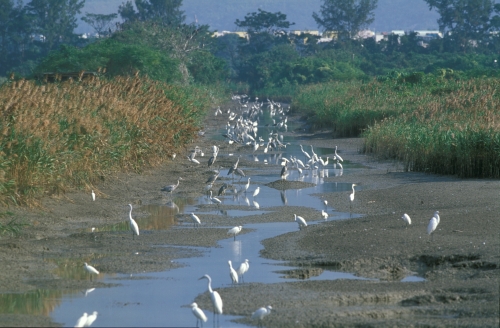Mai Po and Wetland Park, one of best bird-watching destinations in winter
HONG KONG ― The air was gratifying at Mai Po Inner Deep Bay, totally different from the dry, fume-filled atmosphere of the central city. It was refreshing and moist, just to the point where your skin feels comfortable and your lungs feel detoxified, finally having taken in a satisfying amount of pure oxygen.
Who could have imagined that such a fresh air haven of over 16 square kilometers would be tucked behind the thick array of piercing skyscrapers in the city of Hong Kong?
 |
A flock of birds loiter around at Mai Po Inner Deep Bay in Hong Kong. (Mai Po Inner Deep Bay) |
Mai Po and Hong Kong Wetland Park, situated on the northwest of the New Territories, only about 30 minutes ride away from Hong Kong’s downtown area, are like the lungs of the city.
The two, placed adjacent to one another, used to be natural fish ponds and shrimp ponds of smaller sizes but were artificially enlarged and polished: Mai Po, for conservation reasons and the Wetland Park, for the education of the public.
Contrary to Hong Kong’s metropolitan image, urban areas take up less than 25 percent of the city and the rest is countryside. Nearly 40 percent its total land area (1,100 square kilometers) is protected for conservation and recreation. The city has 24 country parks and 17 special areas dedicated to such purposes.
Spending an afternoon at Mai Po not only means detoxifying but it also means that you will be exposed to hundreds of different kinds of birds chirping away at the same time. Yes, it is very noisy, but much kinder on the ear than the sound of cars honking away.
“More than 80,000 birds of over 380 species came here this winter. The number has been increasing in the last few years. Most of them are winter migrants who go back to east China or Siberia in the summer. So winter is a good time to visit if you want to see lots of birds,” said Carrie Ma, conservation officer of the parks.
Mai Po was designated a Ramsar site in 1995. As its main purpose is to conserve, one cannot enter the site without a permit issued by the city’s Agriculture, Fisheries and Conservation department. With a good and logical reason like bird watching, though, it is not so difficult to open the doors.
The place became a very popular visiting spot among bird watchers all over the world in the past several years because rare species like Black-faced spoonbills, a globally endangered species which breeds in the Demilitarized Zone of the Korea Peninsula, were spotted.
 |
Grey Heron, one of the rare birds at Mai Po. (Mai Po Inner Deep Bay) |
“Birds that like the habitat of Mai Po gathered one by one, and the place itself turned more and more suitable for the birds as well,” said Ma.
It takes more than an hour to walk around the park. Plan to spend more time if you are a real bird-lover and visit during the early afternoon because birds are more active at that time of day. Public guided tours are also available.
The Wetland Park, on the other hand, is open to the public except for certain ponds that are exclusively owned by fishermen.
It was transformed into a park in 2006, being the first of its kind in Asia and the largest in the world. Its main goal is to foster public awareness, knowledge and understanding of the inherent values of wetlands.
In its wetland reserve, visitors are welcome to stroll around on the walks ― Stream Walk, Succession Walk, and the Mangrove Boardwalk. Bird hides are installed in every nook and corner so visitors can take a better look at the birds. There are also various bird-watching tours to participate in as well.
A notable point about the wetlands, considering that they are artificial, is that they are maintained in Hong Kong’s traditional way of fish farming.
Water in the parks is completely sucked up during winter, until the ground is all cracked, in order to get rid of all the bacteria. Using oyster shells is another traditional method of taking care of the wetland.
“If it gets too acidic, we put in oyster shells because they have calcium in them. It produces a chemical reaction to decrease the level of acidity in the water,” explained Ma.
For more information on Mai Po, visit www.afcd.gov.hk and for Wetland Park, visit www.wetlandpark.com.
By Park Min-young (
claire@heraldcorp.com)








![[Today’s K-pop] Blackpink’s Jennie, Lisa invited to Coachella as solo acts](http://res.heraldm.com/phpwas/restmb_idxmake.php?idx=644&simg=/content/image/2024/11/21/20241121050099_0.jpg)
